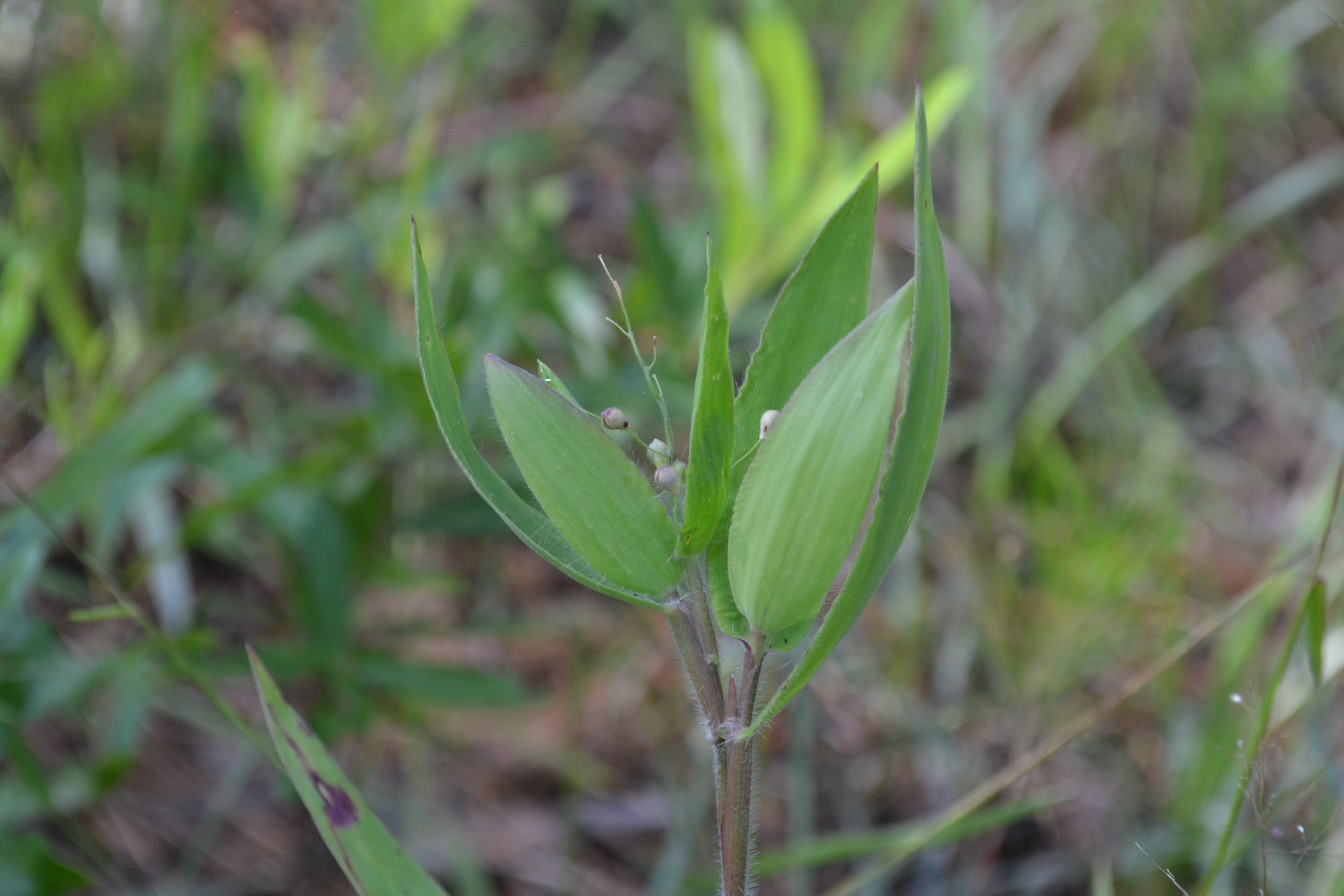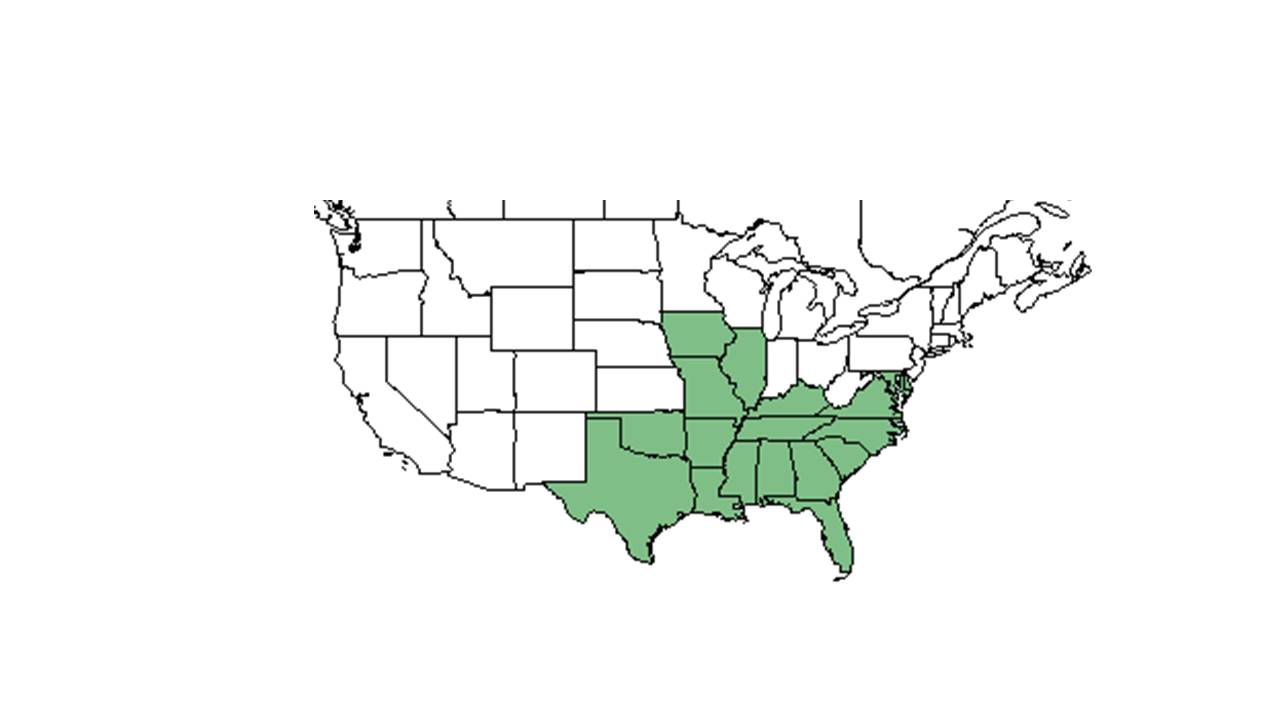Difference between revisions of "Dichanthelium ravenelii"
(→Taxonomic notes) |
|||
| Line 36: | Line 36: | ||
==Ecology== | ==Ecology== | ||
===Habitat=== <!--Natural communities, human disturbed habitats, topography, hydrology, soils, light, fire regime requirements for removal of competition, etc.--> | ===Habitat=== <!--Natural communities, human disturbed habitats, topography, hydrology, soils, light, fire regime requirements for removal of competition, etc.--> | ||
| − | Generally, ''D. ravenelii'' grows in dry sandy to rocky thin openings and woods, and can sometimes be found in moist soils.<ref name= | + | Generally, ''D. ravenelii'' grows in dry sandy to rocky thin openings and woods, and can sometimes be found in moist soils.<ref name=weakley/> ''D. ravenelii'' has also been observed in calcareous coastal hardwood hammocks, calcareous glades, edges of limesinks, pine-oak sandhills, live oak woods, mixed deciduous forests, upland longleaf and shortleaf pine native communities, banks of hardwood forested rivers. It occurs in a wide range of soil conditions from deep sands, to clay, sandy loam, sandy clay, and forest humus. <ref name="FSU Herbarium">Florida State University Robert K. Godfrey Herbarium database. URL: [http://herbarium.bio.fsu.edu http://herbarium.bio.fsu.edu]. Last accessed: June 2014. Collectors: Loran C. Anderson, Charles N. Horn, R. Kral, Raymond Athey, Sidney McDaniel, William J. Clark, H. R. Reed, D J Banks, Ken E. Rogers, Steve Furr, A. E. Radford, R. L. Wilbur, R.K. Godfrey, H. Kurz, Gary R. Knight, R. Komarek, and R. A. Norris. States and Counties: Alabama: Baldwin and Lee. Florida: Franklin, Jackson, Leon, Liberty, and Wakulla. Georgia: Ben Hill, Dougherty, Grady, and Thomas. Kentucky: Crittenden. Louisiana: Jackson and Ouachita. Mississippi: Lauderdale and Pearl River. South Carolina: Greenwood and Laurens. Tennessee: Knox. Texas: Van Zandt.</ref> Can occurs in highly disturbed areas, particularly if sandy. <ref name="FSU Herbarium"/> Tolerates full light to partially shaded conditions. <ref name="FSU Herbarium"/> Apparently limited to well-drained areas even if near wetlands or water bodies. <ref name="FSU Herbarium"/> It thrives in frequently burned areas. <ref name="FSU Herbarium"/> |
Associated species include ''P. commutatum''. <ref name="FSU Herbarium"/> | Associated species include ''P. commutatum''. <ref name="FSU Herbarium"/> | ||
Revision as of 18:31, 25 May 2023
| Dichanthelium ravenelii | |
|---|---|

| |
| Photo by Kevin Robertson | |
| Scientific classification | |
| Kingdom: | Plantae |
| Division: | Magnoliophyta - Flowering plants |
| Class: | Liliopsida – Monocotyledons |
| Order: | Poales |
| Family: | Poaceae ⁄ Gramineae |
| Genus: | Dichanthelium |
| Species: | D. ravenelii |
| Binomial name | |
| Dichanthelium ravenelii (Scribn. & Merr.) Gould | |

| |
| Natural range of Dichanthelium ravenelii from USDA NRCS Plants Database. | |
Common names: Ravenel's rosette grass; Ravenel's witchgrass
Contents
Taxonomic notes
Synonyms: Panicum ravenelii Scribner & Merrill[1]
Varieties: none[1]
Description
Dichanthelium ravenelii is a perennial graminoid.
Generally, for the Dichanthelium genus, they have "spikelets usually in panicles, round or nearly so in cross section, 2-flowered, terminal fertile, basal sterile, neutral or staminate. First glume usually present, 2nd glume and sterile lemma similar; fertile lemma and palea indurate without hyaline margins. Taxonomically our most difficult and least understood genus of grasses, more than 100 species an varieties are ascribed to the Carolinas by some authors. Note general descriptions for species groups (e.g., 1-4, 5-8, 9-13, and 26-62)." [2]
Specifically, for the D. ravenelii species, they are "perennial with distinct basal rosettes; branching, when present, from nodes above basal rosette. Leaves basal and cauline, vernal and autumnal. Culms 2.5-6 dm tall, nodes densely bearded, internodes papillose-pilose pr puberulent. Blades to 12 cm long, 2.5-19 mm wide, glabrous on upper surfaces, puberulent on lower surfaces, margins scaberulous, ciliate, bases cordate, ciliate; sheaths papillose-pilose; ligules densely ciliate, 3-5 mm long; collars densely pubescent. Panicle 6-7 cm long, 5-6 cm broad; rachis short villous, branches spreading or ascending, short villous. Spikelet 3.8-4.2 mm long, obovoid or broadly ellipsoid; pedicels scaberulous, sparsely villous. First glume glabrous, margins scarious, acute, 1.8-2.5 mm long, 2nd glume and sterile lemma pubescent, acute to obtuse, 3.8-4.2 mm long; fertile lemma and palea 1.8-3.5 mm long, nerveless or faintly nerved, yellowish or brownish at maturity, lustrous, acute, or obtuse. Grain 1.2-2 mm long, yellowish or purplish, broadly ellipsoid or subglobose." [2]
Distribution
TX, OK, MO, IA, IL, KY, TN, AR, LA, MS, AL, FL, GA, SC, NC, VA, MD, DE[3]
Ecology
Habitat
Generally, D. ravenelii grows in dry sandy to rocky thin openings and woods, and can sometimes be found in moist soils.[1] D. ravenelii has also been observed in calcareous coastal hardwood hammocks, calcareous glades, edges of limesinks, pine-oak sandhills, live oak woods, mixed deciduous forests, upland longleaf and shortleaf pine native communities, banks of hardwood forested rivers. It occurs in a wide range of soil conditions from deep sands, to clay, sandy loam, sandy clay, and forest humus. [4] Can occurs in highly disturbed areas, particularly if sandy. [4] Tolerates full light to partially shaded conditions. [4] Apparently limited to well-drained areas even if near wetlands or water bodies. [4] It thrives in frequently burned areas. [4]
Associated species include P. commutatum. [4]
Phenology
D. ravenelii generally flowers from May until October.[5] It has been observed to flower April through September and fruit from April to October in Florida.[4][6]
Fire ecology
Populations of Dichanthelium ravenelii have been known to persist through repeated annual burns.[7][8] This species has been found in previously burned pine woods and annually burned savanna.[4]
Herbivory and toxicology
This species can be foraged by white-tailed deer. Most significant time of foraging use is during the winter.[9]
Conservation, cultivation, and restoration
This species is listed as endangered by the Illinois Department of Natural Resources, Endangered Species Protection Board.[3]
Cultural use
Photo Gallery
References and notes
- ↑ 1.0 1.1 1.2 Weakley, A.S. 2020. Flora of the Southeastern United States. Edition of 20 October 2020. University of North Carolina at Chapel Hill, Chapel Hill, North Carolina.
- ↑ 2.0 2.1 Radford, Albert E., Harry E. Ahles, and C. Ritchie Bell. Manual of the Vascular Flora of the Carolinas. 1964, 1968. The University of North Carolina Press. 142-153. Print.
- ↑ 3.0 3.1 USDA, NRCS. (2016). The PLANTS Database (http://plants.usda.gov, 1 May 2019). National Plant Data Team, Greensboro, NC 27401-4901 USA.
- ↑ 4.0 4.1 4.2 4.3 4.4 4.5 4.6 4.7 Florida State University Robert K. Godfrey Herbarium database. URL: http://herbarium.bio.fsu.edu. Last accessed: June 2014. Collectors: Loran C. Anderson, Charles N. Horn, R. Kral, Raymond Athey, Sidney McDaniel, William J. Clark, H. R. Reed, D J Banks, Ken E. Rogers, Steve Furr, A. E. Radford, R. L. Wilbur, R.K. Godfrey, H. Kurz, Gary R. Knight, R. Komarek, and R. A. Norris. States and Counties: Alabama: Baldwin and Lee. Florida: Franklin, Jackson, Leon, Liberty, and Wakulla. Georgia: Ben Hill, Dougherty, Grady, and Thomas. Kentucky: Crittenden. Louisiana: Jackson and Ouachita. Mississippi: Lauderdale and Pearl River. South Carolina: Greenwood and Laurens. Tennessee: Knox. Texas: Van Zandt.
- ↑ Cite error: Invalid
<ref>tag; no text was provided for refs namedWeakley - ↑ Nelson, G. PanFlora: Plant data for the eastern United States with emphasis on the Southeastern Coastal Plains, Florida, and the Florida Panhandle. www.gilnelson.com/PanFlora/ Accessed: 1 MAY 2019
- ↑ Robertson, K.M. Unpublished data collected from Pebble Hill Fire Plots, Pebble Hill Plantation, Thomasville, Georgia.
- ↑ Platt, W.J., R. Carter, G. Nelson, W. Baker, S. Hermann, J. Kane, L. Anderson, M. Smith, K. Robertson. 2021. Unpublished species list of Wade Tract old-growth longleaf pine savanna, Thomasville, Georgia.
- ↑ Gee, K. L., et al. (1994). White-tailed deer: their foods and management in the cross timbers. Ardmore, OK, Samuel Roberts Noble Foundation.